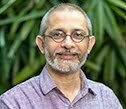
EDUCATION:
1995 MArch University of Minnesota Minneapolis, United States of America
1990 BArch University of Mumbai Mumbai, Maharashtra, India
Countries: USA, India, South Korea, UAE
States: All relevant states
Cities: All relevant cities
Languages: English, Hindi, Marathi
Prasad Vaidya leads the Solar Decathlon India and the Sustainable Energy Lab at IIHS. He focuses on the interdisciplinary area of sustainable energy and buildings, including practice, research and teaching. He also provides oversight and assistance to the planning, design, and execution of energy systems, efficiency and net-carbon neutrality for the IIHS Kengeri campus. Prasad Vaidya is a LEED Fellow and has worked in the area of environmental sustainability for over 30 years. His experience includes energy policy, energy efficiency programme development, and net-zero energy building projects in the United States of America, India, UAE, and South Korea.
Prasad was Professor and Area Chair for Building Energy Performance at CEPT University in India, where he established the MTech in Building Energy Performance programme. He taught graduate-level courses on building science, passive design, HVAC analysis, electric lighting and daylighting, whole building energy simulation, environmental impact of buildings, communication for energy efficiency business, and integrated design for net-zero energy buildings. He coached students on public speaking, presentation, and job-interviewing skills. At CEPT, he also mentored student teams for the US Department of Energy’s Race to Zero and Solar Decathlon Competition. He has taught graduate-level courses on sustainability and daylighting at the University of Minnesota, and continuing education courses as ASHRAE and USGBC faculty.
As a partner at The Weidt Group, he worked on the energy efficiency of over 150 buildings including net-zero energy buildings. In India, he has worked on policy-level implementation of the Energy Conservation Building Code (ECBC). He led the development of ECOnirman Whole Building Performance, an online energy simulation tool for ECBC compliance. His work in India also includes design and construction experience in passive solar design at building and urban planning scales, use of low embodied energy materials and appropriate construction technologies. He has been a member of the Technical Resources Group for the Clinton Climate Initiative.
Prasad co-authored Fundamentals of Integrated Design for Sustainable Building, published by John Wiley and Sons, which is widely used as a textbook in undergraduate programmes. He is on the board of advisors for multiple academic institutions.